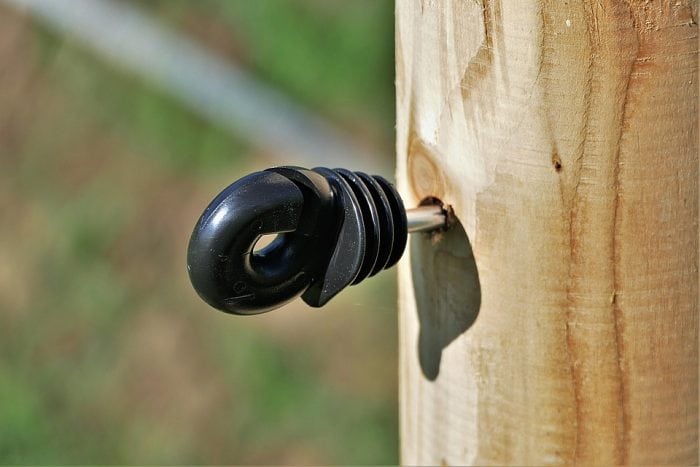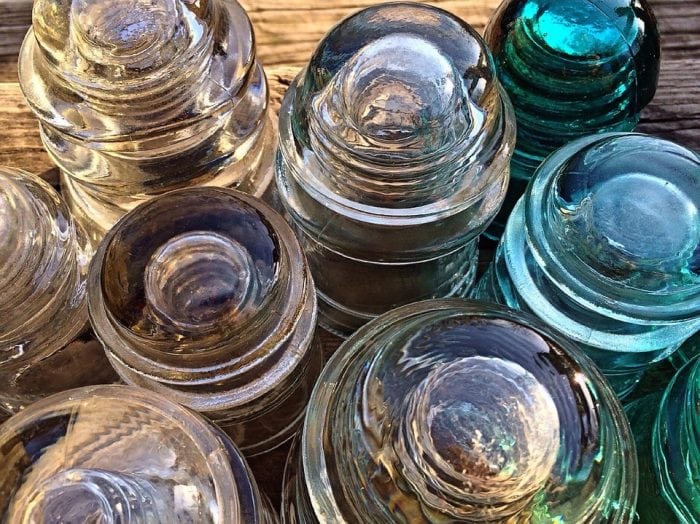
An insulator is a material or device which restricts the flow of an electrical current. The fact that insulators can interrupt a current means that they are useful as devices that protect people from electricity. Another type of insulator is a thermal insulator, which restricts the flow of heat across an area, rather than the flow of electricity.
“Electricity is really just organized lightning.” — George Carlin
Insulation – Low Conductivity And High Resistivity
You’ve probably heard before that certain objects or chemicals like metals and water conduct electricity. This means that they amplify or allow the electric particles to flow throughout the substance or through an area freely. A conductor is, therefore, the opposite of an insulator. Insulators are able to interrupt the flow of an electric current because of two attributes: low conductivity and high resistivity.
The atoms found within an insulating material have electrons that are tightly bound with one another, and because of this, they do not move much in the material. Since the electrons within the atom are in fairly static positions, an electrical current (which is just the movement of particles with an electric charge – such as protons which have a positive charge and electrons which have a negative charge) Can easily pass through the atoms of the insulator.
A material is said to have high resistance when it can effectively reduce the amount of current which passes through it. The property of electrical resistance is measured with units dubbed ohms. One ohm of resistance is equal to conditions where one volt will produce one ampere of current. Ohms are very small units and can grow exponentially as you move from more conductive materials to more resistant material. A conductor frequently has just a few ohms of resistance, while insulators have billions of ohms. A material without resistance is referred to as a superconductor.
“Neon signs don’t consume much power, but they look like they do. A cousin of fluorescent lighting, neon is actually quite energy efficient. A neon tube glows coolly when high-voltage, low-amperage electrical power excites the gas within it.” — Virginia Postrel
Conductors, being the opposite of an insulator, have opposite attributes as well: a high conductivity to either heat or electrical currents and low resistance. If the bound electrons within the atoms of an insulator give it resistance to electrical currents, the electrons found within conductors like metals aren’t tightly bound and move rather freely. This means that heat and electricity can easily penetrate conductors. Out of all the various metals, copper is one of the most widely used conductors, especially in wires. Water is also an excellent conductor of electricity, as are most liquids.
Note that while insulators make it more difficult for an electrical current to move from one area to another, every insulator will eventually conduct electricity and heat if they are exposed to voltages high enough. Extremely high voltages will cause the insulation to degrade, and the point at which this occurs is known as the dielectric strength – the voltage at which an insulator loses insulating capacity. One of the best illustrations of this is air, which is usually a decent insulator. Yet despite the vast amount of air in the atmosphere, lightning can pass right through it because of the high voltage involved in the lightning, which degrades the air’s insulation ability.
Breakdown Voltages
Various insulators have various breakdown voltages or dielectric strengths. As an example, plastic is not fit for use in industrial applications, because the breakdown voltage isn’t very high. Yet plastic is fine for use in homes because the voltage there is rather low. For industrial applications ceramic is often used, because it has an extremely high breakdown point.

Photo: HOerwin56 via Pixabay, CC0
Various types of insulators include glass, plastic, wood, and rubber. Porcelain and glass insulation is frequently used in cases of high-voltage transmission, and glass was one of the first insulators to be widely used in the transmission of electrical currents, though since then cheaper alternatives are typically favored. Plastic does not have the same level of resistance as glass, though it is still fairly resistant and therefore used more frequently for mass application. Plastics are often used to insulate cables and wires.
Wood is also a commonly used heat insulator, thanks to how dense wood often is. Wood is frequently used to insulate items that will grow hot such as cookware. Rubber in both its synthetic and natural forms was frequently used as an insulator from the late 1800s until the mid-1950s when the availability of plastic largely replaced the use of rubber. However, rubber is still used in some industrial applications today and frequently combined with plastic insulators.

Photo: Wokandapix via Pixabay, CC0
The first major electrical system to use insulator were telegraph lines. When telegraph lines were attached to wooden poles, performance suffered greatly especially during rain or on high humidity days. Glass insulators were sometimes attached to telegraph poles to combat this problem. Ceramic insulators were produced during the mid-1800s and saw use throughout the United Kingdom. When the suspension type insulators were created, the transmission of high-voltage power became possible. The larger and heavier electrical transmission lines became, the better their insulators had to be. When line voltages passed 60,000 V, insulators were created with a safety rating of 80,000 V.
Types Of Insulators
The types of insulators you see on power lines are known as suspension insulators, which have wires suspended through a concatenated group of disk-shaped insulation units. This design assists in the creation of insulation units with different breakdown voltages (depending on the voltage of the power line), as the different modular units can simply be strung together to meet the insulation requirement.
“I ate fiberglass insulation. It wasn’t cotton candy like the guy said… my tummy itches.” — Stave Carell
Unlike electrical insulation, the insulation found within the walls of a building is used to prevent the transfer of heat. Proper insulation can help buildings stay cool in the summertime and warm in the wintertime. Good insulation also helps the house be energy efficient, not having to power AC or heating systems as often, thus saving the residents money. Building insulation can be made out of a variety of materials, like synthetic fiber or concrete block. Fiberglass insulation is frequently inserted into the attic or walls of a home, while insulating plastic films are frequently used to cover windows and window frames.
An important factor when choosing what type of insulator to use is air permeability. Air permeability refers to how easily air flows through the pores within the material. This is an important decision when it comes to thermal insulators. Effective insulators often have a high air permeability attribute, because the air itself functions as an insulator. Examples of permeable substances that are good insulators include fiberglass and oven mitts.









